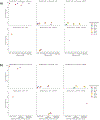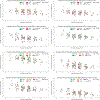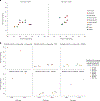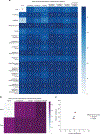Optimizing the Cell Painting assay for image-based profiling
- PMID: 37344608
- PMCID: PMC10536784
- DOI: 10.1038/s41596-023-00840-9
Optimizing the Cell Painting assay for image-based profiling
Abstract
In image-based profiling, software extracts thousands of morphological features of cells from multi-channel fluorescence microscopy images, yielding single-cell profiles that can be used for basic research and drug discovery. Powerful applications have been proven, including clustering chemical and genetic perturbations on the basis of their similar morphological impact, identifying disease phenotypes by observing differences in profiles between healthy and diseased cells and predicting assay outcomes by using machine learning, among many others. Here, we provide an updated protocol for the most popular assay for image-based profiling, Cell Painting. Introduced in 2013, it uses six stains imaged in five channels and labels eight diverse components of the cell: DNA, cytoplasmic RNA, nucleoli, actin, Golgi apparatus, plasma membrane, endoplasmic reticulum and mitochondria. The original protocol was updated in 2016 on the basis of several years' experience running it at two sites, after optimizing it by visual stain quality. Here, we describe the work of the Joint Undertaking for Morphological Profiling Cell Painting Consortium, to improve upon the assay via quantitative optimization by measuring the assay's ability to detect morphological phenotypes and group similar perturbations together. The assay gives very robust outputs despite various changes to the protocol, and two vendors' dyes work equivalently well. We present Cell Painting version 3, in which some steps are simplified and several stain concentrations can be reduced, saving costs. Cell culture and image acquisition take 1-2 weeks for typically sized batches of ≤20 plates; feature extraction and data analysis take an additional 1-2 weeks.This protocol is an update to Nat. Protoc. 11, 1757-1774 (2016): https://doi.org/10.1038/nprot.2016.105.
© 2023. Springer Nature Limited.
Figures















References
-
- Pratapa A, Doron M & Caicedo JC Image-based cell phenotyping with deep learning. Curr. Opin. Chem. Biol 65, 9–17 (2021). - PubMed
Publication types
MeSH terms
Grants and funding
LinkOut - more resources
Full Text Sources

